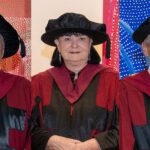A joint research project using the new Geoscience Atom Probe Facility at the WA School of Mines, Curtin University has examined lead loss in zircons to determine the timing of different geological events stored in defects within the mineral.
Applied Geology Professor Steven Reddy said by using atom probe microscopy, the researchers were able to look at the nanoscale distribution of lead in a zircon grain that has undergone lead loss and show that there were isolated lead reservoirs that could be used to date the mineral.
He said the structure of zircon − the most widely used mineral for dating geological events − incorporates different isotopes of uranium which decay to different lead isotopes, which can be measured to yield the age of the mineral sample. However, lead loss from the grain usually ruins the chances of getting good age data.
“Aside from atom probe microscopy, there are no other techniques that allow you to look at the isotopic composition of 10 nanometre-sized clusters of lead in a mineral,” Professor Reddy said.
“Our research shows that the volumes of materials analysed by other techniques are likely to be a mixture of different lead reservoirs that date different parts of the geological history.
“This is the first study to show what lead loss looks like at the nanoscale and it opens up a whole new way of dating geological events.”
Aside from Curtin scientists, researchers from several American universities collaborated on the project, including lead author Dr Emily Peterman, from Bowdoin College in Maine, who visited Curtin to use the cutting-edge facility earlier this year.
Professor Reddy said atom probe microscopy involved analysing tiny needle-shaped specimens to provide three-dimensional sub-nanometre scale information of the position and type of individual atoms in the mineral specimen.
“Curtin’s laboratory is the only geoscience-focused atom probe facility in the world,” he said.
“The needles are incredibly fine – to put it in perspective, the volume of material in a needle is about a billion times smaller than a grain of sand.
“Our findings are at the forefront of a completely new research field in nanogeochronology,” Professor Reddy said.
The research, Nanogeochronology of discordant zircon measured by atom probe microscopy of Pb-enriched dislocation loops, was published in Science Advances on 2 September 2016.
The Geosciences Atom Probe is housed in the John de Laeter Centre, Curtin University and forms part of the National Resource Science Precinct’s (NRSP) Advanced Resource Characterisation Facility (ARCF), a joint project between CSIRO, Curtin University and The University of Western Australia, with funding support from the Science and Industry Endowment Fund.


